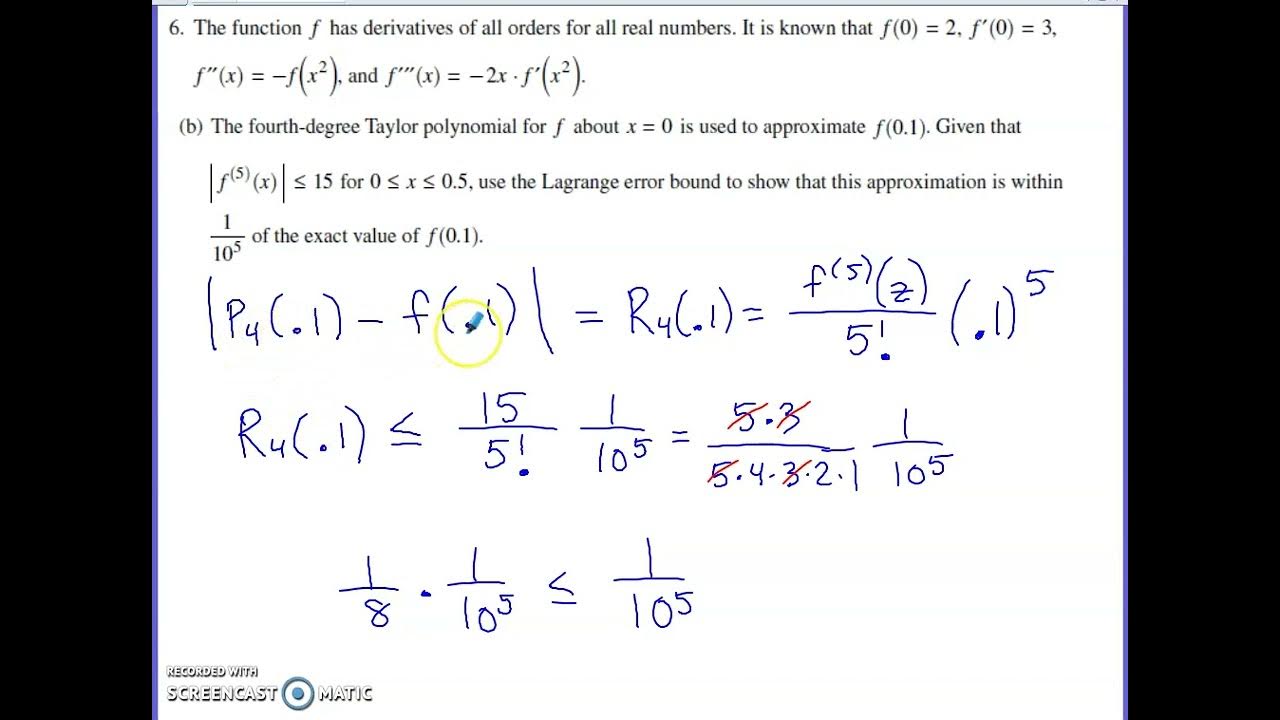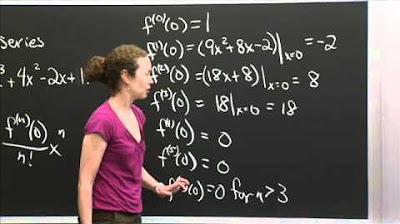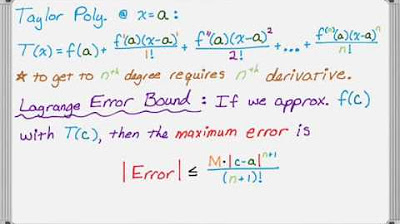Worked example: coefficient in Taylor polynomial | Series | AP Calculus BC | Khan Academy
TLDRThis educational video script guides viewers through the process of finding the coefficient for a specific term in a Taylor polynomial. Centered at x = -2, the script explains the general form of the Taylor polynomial and emphasizes the importance of evaluating the function and its derivatives at the center point. The focus is on identifying the coefficient of the term containing x plus two to the fourth power. The process involves calculating the fourth derivative of the original function, evaluating it at x = -2, and dividing by four factorial, ultimately simplifying to a coefficient of 60.
Takeaways
- 🔢 The goal is to find the coefficient of the term containing (x + 2)^4 in the Taylor polynomial centered at x = -2 for the function f(x).
- 📝 The general form of the Taylor polynomial is established, with each term involving the function and its derivatives evaluated at the center point, x = -2.
- 🧮 The constant term is derived from the function value at x = -2 divided by 0 factorial.
- 🧑🏫 The linear term involves the first derivative evaluated at x = -2, divided by 1 factorial, and multiplied by (x + 2).
- 🔢 The quadratic term includes the second derivative at x = -2, divided by 2 factorial, and multiplied by (x + 2)^2.
- 🧮 The cubic term is derived from the third derivative at x = -2, divided by 3 factorial, and multiplied by (x + 2)^3.
- 🔍 The term of interest, the fourth-degree term, involves the fourth derivative at x = -2, divided by 4 factorial, and multiplied by (x + 2)^4.
- 🔢 The coefficient of the term (x + 2)^4 is the fourth derivative of the function evaluated at x = -2 divided by 4 factorial.
- 🧮 Calculations show the first derivative as 6x^5 - 3x^2 and the second derivative as 30x^4 - 6x.
- 🔢 The third derivative is 120x^3 - 6, and the fourth derivative is 360x^2.
- 📉 Evaluating the fourth derivative at x = -2 gives 360 * 4.
- 🧮 Dividing 360 * 4 by 4 factorial simplifies to 60.
- ✅ The coefficient for the (x + 2)^4 term is 60.
Q & A
What is the general form of the Taylor polynomial centered at x = -2?
-The general form of the Taylor polynomial p(x) centered at x = -2 is given by p(x) = f(-2) + f'(-2)/1! * (x+2) + f''(-2)/2! * (x+2)^2 + f'''(-2)/3! * (x+2)^3 + f''''(-2)/4! * (x+2)^4 + ...
What do we need to find to determine the coefficient for the term containing (x+2)^4?
-We need to find the fourth derivative of the original function, evaluated at x = -2, and divide it by 4! (four factorial).
How is the first derivative of the given function f(x) determined?
-The first derivative, f'(x), is determined using the power rule: f'(x) = 6x^5 - 3x^2.
What is the second derivative of the given function?
-The second derivative, f''(x), is f''(x) = 30x^4 - 6x.
What is the third derivative of the given function?
-The third derivative, f'''(x), is f'''(x) = 120x^3 - 6.
How is the fourth derivative of the function calculated?
-The fourth derivative, f''''(x), is calculated as f''''(x) = 360x^2.
What is the value of the fourth derivative evaluated at x = -2?
-The value of the fourth derivative evaluated at x = -2 is 360 * 4 = 1440.
How do we calculate the coefficient for the (x+2)^4 term?
-We calculate the coefficient by dividing the value of the fourth derivative at x = -2 (1440) by 4!, which is 1440 / 24.
What is the simplified value of 1440 / 4!?
-The simplified value of 1440 / 4! is 1440 / 24 = 60.
What is the final coefficient for the (x+2)^4 term in the Taylor polynomial?
-The final coefficient for the (x+2)^4 term in the Taylor polynomial is 60.
Outlines
📚 Introduction to Taylor Polynomials
The script begins with a teacher introducing the concept of Taylor polynomials, specifically focusing on finding the coefficient for a term containing x to the power of four, in the polynomial centered at x equals negative two. The teacher encourages students to try solving the problem independently before guiding them through the process. The explanation starts by outlining the general form of the Taylor polynomial, emphasizing the importance of evaluating the function and its derivatives at the center point, which is x equals negative two in this case.
🔍 Deriving the Taylor Polynomial
The teacher proceeds to explain the process of deriving the Taylor polynomial by writing out the terms of the polynomial, including the zeroth, first, second, and third derivatives evaluated at x equals negative two. The focus is on identifying the term with x to the fourth power, which requires calculating the fourth derivative of the original function. The script provides a step-by-step breakdown of the derivatives, using the power rule to find each successive derivative of the given function.
📘 Calculating the Coefficient
The script then moves on to the calculation of the coefficient for the x to the fourth power term. The teacher demonstrates how to evaluate the fourth derivative at x equals negative two and divide it by four factorial to find the coefficient. The process involves simplifying the expression to find the numerical value of the coefficient, which is shown to be 60 after performing the division and simplification.
Mindmap
Keywords
💡Taylor Polynomial
💡Coefficient
💡Derivative
💡Factorial
💡Power Rule
💡Centering
💡Fourth Degree Term
💡Evaluation
💡Polynomial Approximation
💡Function Behavior
💡Differentiation
Highlights
Introduction to finding the coefficient of a specific term in the Taylor polynomial centered at x=-2.
General form of the Taylor polynomial p(x) with the given center point.
Explanation of the pattern in the Taylor polynomial coefficients and powers of (x+2).
Focus on finding the coefficient for the term containing x^4 in the Taylor polynomial.
Derivation of the formula for the coefficient of the x^4 term using derivatives.
Calculation of the first derivative of the given function using the power rule.
Derivation of the second derivative and simplification.
Calculation of the third derivative and simplification steps.
Finding the fourth derivative, which is crucial for the coefficient calculation.
Evaluation of the fourth derivative at x=-2 to find the coefficient numerator.
Division of the evaluated fourth derivative by 4! to find the final coefficient.
Simplification of the coefficient calculation resulting in 60.
Emphasis on the importance of correctly evaluating derivatives for Taylor polynomial coefficients.
Illustration of the process to find the coefficient of any term in a Taylor polynomial.
Highlighting the consistency in the pattern of coefficients and powers in the Taylor polynomial.
Demonstration of the step-by-step approach to derive and calculate the coefficients.
Final conclusion with the coefficient for the x^4 term being 60.
Transcripts
Browse More Related Video

2023 AP Calculus BC Free Response Question #6

2023 AP Calculus BC FRQ #6

Taylor's Series of a Polynomial | MIT 18.01SC Single Variable Calculus, Fall 2010

Taylor Polynomials from Taylor's Formula

Worked example: coefficient in Maclaurin polynomial | Series | AP Calculus BC | Khan Academy

The Lagrange Error Bound for Taylor Polynomials
5.0 / 5 (0 votes)
Thanks for rating: